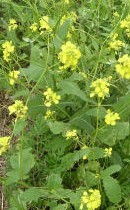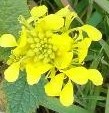 Wild mustard is an annual weed native to Europe and Asia but is wide spread in North American and can be found in throughout the United States. It prefers full sun and fertile soil but tolerates some shade and many different soil types. It is common in gardens, cultivated fields, pastures, roadsides, waste areas and is especial troublesome in winter small grains where it can significantly reduce yield. Although the flowers of wild mustard are a prime source of pollen and nectar for pollinating insects, the plant is an alternative host for a number of disease causing organisms that can affect vegetable crops such as broccoli, cauliflower, Brussels sprouts, and cabbage.
Wild mustard is an annual weed native to Europe and Asia but is wide spread in North American and can be found in throughout the United States. It prefers full sun and fertile soil but tolerates some shade and many different soil types. It is common in gardens, cultivated fields, pastures, roadsides, waste areas and is especial troublesome in winter small grains where it can significantly reduce yield. Although the flowers of wild mustard are a prime source of pollen and nectar for pollinating insects, the plant is an alternative host for a number of disease causing organisms that can affect vegetable crops such as broccoli, cauliflower, Brussels sprouts, and cabbage.
 Description: A cool weather crop, wild mustard is erect, branched in its upper part, and grows 2-4 feet high on green stems
Description: A cool weather crop, wild mustard is erect, branched in its upper part, and grows 2-4 feet high on green stems  that may have a purplish tinge. The upper leaves form a rosette and are ovate and 2 to 8 inches long. They have petioles 1/3-1.5″ long and uneven lobes with toothed margins. The upper leaves clasp the stem, and are unlobed and smaller as they ascend . Bright yellow flowers with four petals and measuring ¾” wide are produced in clusters at the tips of branches during the spring and early summer. Long thin seed pods 2-3 inches in length have a short thick base and long flattened beak. Each pod contains 10-18 seeds. A single plant can produce over 3,000 seeds that can persist in the soil for decades. The root system is a fibrous taproot.
that may have a purplish tinge. The upper leaves form a rosette and are ovate and 2 to 8 inches long. They have petioles 1/3-1.5″ long and uneven lobes with toothed margins. The upper leaves clasp the stem, and are unlobed and smaller as they ascend . Bright yellow flowers with four petals and measuring ¾” wide are produced in clusters at the tips of branches during the spring and early summer. Long thin seed pods 2-3 inches in length have a short thick base and long flattened beak. Each pod contains 10-18 seeds. A single plant can produce over 3,000 seeds that can persist in the soil for decades. The root system is a fibrous taproot.

 Control: Because wild mustard reproduces only by seed and the seed can be long lived, control measures should be aimed at removing the plants before they go to seed. This can easily be done by hand pulling or tilling before or while the plants are flowering. Herbicides such as 2,4-D, MCPA, MCPB are effective for severe infestations.
Control: Because wild mustard reproduces only by seed and the seed can be long lived, control measures should be aimed at removing the plants before they go to seed. This can easily be done by hand pulling or tilling before or while the plants are flowering. Herbicides such as 2,4-D, MCPA, MCPB are effective for severe infestations.